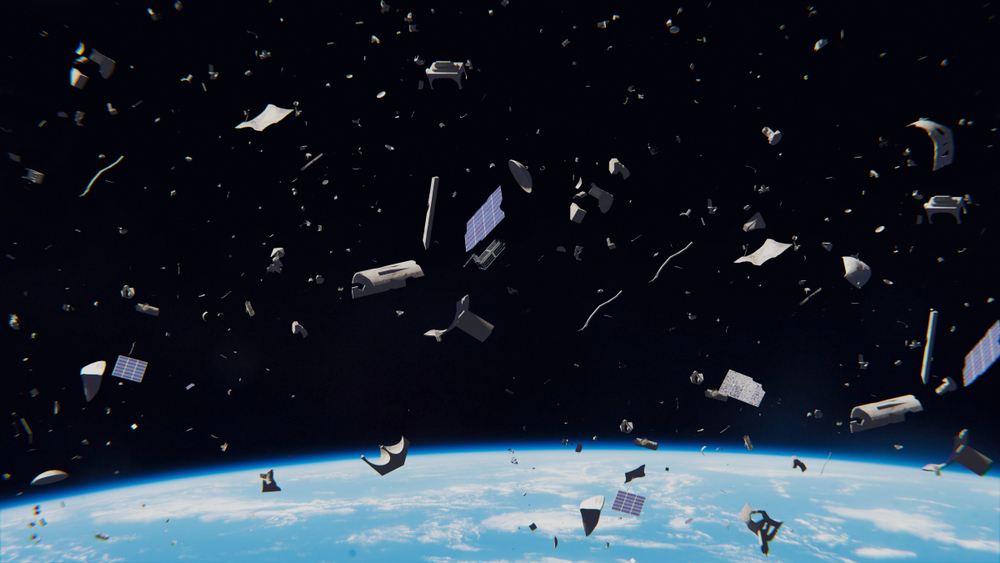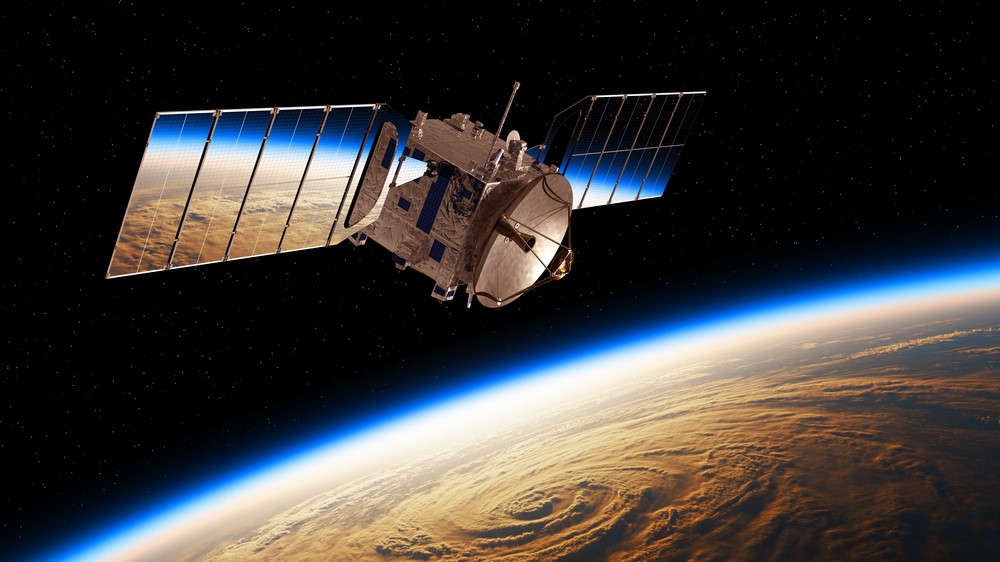
How many satellites orbit Earth?
The number is increasing fast, which is problematic.

Human-made satellites were once rare in low Earth orbit (LEO), with just a handful of them rotating around the planet at the dawn of the Space Age in the 1950s. But now, there are thousands of satellites swarming around Earth, with even more waiting to join them.
So, to put an exact number on it, how many satellites are orbiting Earth, and how many might join them in the near future? And once all of these satellites are spaceborne, what types of problems might they cause?
After the Soviet Union launched Sputnik, the world's first human-made satellite, in 1957, a slow but steady stream of satellites entered LEO, with between 10 and 60 launched annually until the 2010s, Supriya Chakrabarti, a professor of physics at the University of Massachusetts Lowell, wrote in an article published on Space.com, a Live Science sister site. Since then, that rate has skyrocketed, with more than 1,300 new satellites launched into LEO in 2020 and more than 1,400 satellites launched in 2021, Chakrabarti wrote. In total, there were around 7,500 satellites in LEO as of September 2021, according to the United Nations' Outer Space Objects Index.
Related: Does the moon rotate?
Crowded market
The number of satellites in LEO, a region that spans up to 1,424 miles (2,000 kilometers) from Earth, will continue to increase at an exponential rate in the coming decades. That's because private companies are setting up their own megaconstellations, each containing thousands of individual satellites, which will be used to develop faster online networks and deliver a range of other services, such as monitoring climate change.
This increased activity is happening now largely because of dropping costs, said Aaron Boley, an astronomer at The University of British Columbia. "We know SpaceX, OneWeb, Amazon and StarNet/GW [China's satellite network] have proposed a combined satellite total of 65,000 when including all phases" of their satellite programs, Boley told Live Science. And "well over 100,000 satellites have been proposed" in total, he added.
In October 2021, Rwanda also announced its own megaconstellation, named Cinnamon, which could contain over 320,000 satellites. It is unclear when this project might become a reality, but the country has requested permission to begin the project, according to a tweet by the Rwanda Space Agency.
Sign up for the Live Science daily newsletter now
Get the world’s most fascinating discoveries delivered straight to your inbox.
However, all these new satellites come with a host of new issues, as highlighted by a May 2021 study into megaconstellations co-led by Boley and published in the journal Scientific Reports.
"It causes a space traffic management problem, it will exacerbate the proliferation of space debris, it is interfering with astronomy and stargazing, and the rocket launches and reentries cause atmospheric pollution," Boley said. "We're still trying to understand the extent of the impacts."
Space traffic and debris
As more satellites are launched into orbit in the coming decades, the number of collisions and subsequent space debris are likely to soar. There are already at least 128 million pieces of debris in LEO. Of those, around 34,000 are over 4 inches (10 centimeters), according to the Natural History Museum in London, and there will be even more in the future.
"The safe operation of that many satellites is going to be a major challenge," Boley said. "An accident in one particular orbit that generates significant space debris has the potential to affect a wide range of orbits."
Collisions aren't the only source of space debris; satellites can also break down from prolonged exposure to intense ultraviolet radiation in LEO, Boley said.
Space debris has the potential to cause significant damage to other satellites, as well as other spacecraft. In June 2021, the International Space Station was struck by a piece of debris that punctured a hole in a robotic arm; luckily, the space station and the astronauts inside avoided any major damage, Live Science previously reported.
Related: How do tiny pieces of space junk cause incredible damage?
Eventually, the number of satellites in LEO could lead to a runaway chain of collisions that would scatter space debris around LEO, to the point where we would be unable to launch new rockets. This possibility is known as the Kessler syndrome, and many astronomers fear that it may prevent humanity from becoming a multiplanet species if we cannot keep space debris under control.

"The Kessler effect will not have a clear moment that it turns on," Boley said. "Rather, it is a gradual transition due to an imbalance of debris generation and debris removal rates." But some evidence already suggests that active debris removal from LEO is needed to avoid the Kessler syndrome from taking hold, he added.
However, removing space debris from LEO is logistically challenging and there is still no agreed upon method of removal, according to Scientific American.
Launches and reentry
The space industry has a much lower carbon footprint than other industries, such as the aviation industry. An average rocket launch releases between 220 and 330 tons (200 to 300 metric tons) of carbon into Earth's atmosphere, according to The Guardian. For comparison, an average long-haul commercial flight releases around 2 to 3 tons (1.8 to 2.7 metric tons) of carbon per passenger, and there are tens of millions of flights every year.
However, as the high demand for rockets needed to launch satellites increases, the carbon emissions from rocket launches have increased by 5.6% annually, according to The Guardian.
And it's not just satellite launches that pose an environmental problem. As satellites eventually fall out of orbit and reenter Earth's atmosphere, they also release chemicals into the atmosphere, Boley said.
Boley's study into megaconstellations revealed that, in the future, satellite reentries could end up depositing more of certain elements, such as aluminum, into Earth's atmosphere than meteorites do. Scientists are unsure what the potential impacts of this could be, but human-caused changes to the atmospheres' chemistry, such as the release of chlorofluorocarbons (CFCs) from aerosols that caused the hole in the ozone layer, do not tend to end well.
Moreover, as satellites reenter the atmosphere, they can also cause significant damage on the ground. However, modern satellites are designed to break up into smaller pieces upon reentry, so less material makes it to the surface. And, usually, falling space junk lands in the water, which covers about 71% of Earth's surface.
Related: What would happen if you shot a gun in space?
Light pollution
In the future, increased satellite activity will be clearly visible from Earth. The metal objects will act like mirrors, reflecting light back toward the Earth's surface, and the sheer number of them will drastically alter our view of the night sky.
A study on light pollution — co-written by Boley, posted to the arXiv database in September 2021 and submitted to The Astronomical Journal — revealed that as much as 8% of the light in the night sky could come from satellites in the future. The study also found that places near 50 degrees north and south latitude, like British Columbia and Patagonia, could be more severely impacted by satellite light pollution than other locations, due to the orbits of proposed satellites.

"This is such a fundamental change to our view of the sky that it requires greater scrutiny," co-author Hanno Rein, an astronomer at the University of Toronto Scarborough, said in a statement. "It will be experienced by everyone."
In the future, Boley said, as many as 1 in every 10 "stars" in the sky could actually be satellites, which would "continuously cause the heavens to be rearranged."
The satellites won't interfere only with amateur stargazing but also professional astronomers' observations. "Some astronomical research will see only moderate impacts, but the effects on wide-field surveys could be substantial," Boley said.
Finding a balance
It is clear that the predicted rate of satellites being put into LEO is unsustainable, but satellites also provide us with important services."We are deeply connected to satellites," Boley said. "Satellites play a major role in our supply chain, financial transactions, weather monitoring, climate science, global communications and search and rescue."
Therefore, we need to find a way to balance out the benefits and impacts, Boley said.
"I don't think a full stop on satellite launches would work," Boley said. "However, slowing things down and delaying the placement of 100,000 satellites until we have better international rules would be prudent."
Editor's Note: This article was updated at 11:30 a.m. ET on Jan 6, 2022, to clarify a fact about the number of satellites in LEO.
Originally published on Live Science.

Harry is a U.K.-based senior staff writer at Live Science. He studied marine biology at the University of Exeter before training to become a journalist. He covers a wide range of topics including space exploration, planetary science, space weather, climate change, animal behavior and paleontology. His recent work on the solar maximum won "best space submission" at the 2024 Aerospace Media Awards and was shortlisted in the "top scoop" category at the NCTJ Awards for Excellence in 2023. He also writes Live Science's weekly Earth from space series.









